Water scarcity report - 21 August 2025
The Spey, Almond and Tweed have been raised to Moderate Scarcity, joining the Deveron, Ythan, Don (Aberdeenshire), Esk (Angus), Firth of Tay and Tyne (Lothian) catchments. The Earn and Orkney have been raised to Alert while the Findhorn, Dee (Aberdeenshire) and Firth of Forth catchments remain at Alert.
The Forth, Esk (Dumfriesshire), Annan, Nith, Dee (Galloway), Cree and Leven (Dunbartonshire) have been raised to Early Warning. Shetland has recovered to Normal Conditions. The rest of the country remains at Early Warning or Normal Conditions.
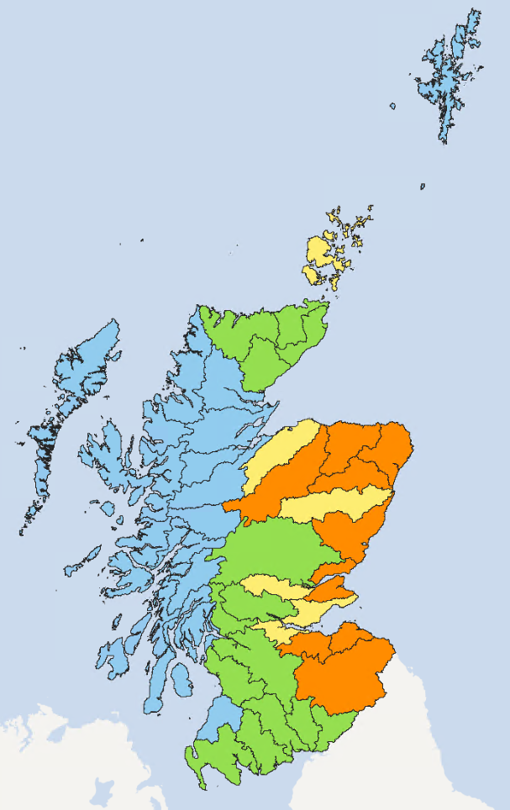
Situation summary
Despite localised thundery downpours at the end of last week, the short intense nature of the rainfall had little impact on the current water scarcity situation across much of Scotland. Rainfall data for the east coast of Scotland shows that every month since the beginning of the year has had less than average rainfall. In some parts of the east, this deficit extends back to June 2024, where these areas have received 40% less rainfall compared to the long-term average.
As a result, the Deveron, Ythan, Don (Aberdeenshire), Esk (Angus), Firth of Tay and Tyne (Lothian) catchments remain at moderate scarcity and are now also joined by the Spey, Almond and Tweed.
If flows remain very low in the Deveron, Ythan, Upper and Lower Don in Aberdeenshire, North Fife and Lower Tweed these areas will go to Significant scarcity next week. You can monitor this on the Drought Risk Assessment Tool.
Due to the further drying of ground conditions and little to no rain forecast over the coming week, Orkney and the Earn catchment have been raised to Alert and the Forth, Esk (Dumfriesshire), Annan, Nith, Dee (Galloway), Cree and Leven (Dunbartonshire) have been raised to Early Warning.
The Findhorn, Dee (Aberdeenshire) and Firth of Forth catchments remain at Alert.
Meanwhile, Shetland has recovered to Normal Conditions.
The rest of the country remains at Early Warning or Normal conditions.
What do the map colours mean?
| Normal conditions | Early warning | Alert | Moderate scarcity | Significant scarcity |
|---|---|---|---|---|
| Blue | Green | Yellow | Orange | Red |
Water scarcity area descriptions
Weather Forecast
High pressure over the UK brings settled conditions over the next 5 days. It will remain largely dry although the odd light shower can’t be ruled out.
Advice for water users
We advise water users, including those with private water supplies, to be aware of the potential risk of water scarcity this summer, and for businesses to plan ahead where possible. Advice for abstractors and irrigators.
Supporting information
This section goes into more detail on the data behind the water scarcity levels.
Rainfall and river flows
These maps show rainfall and river flows relative to the long-term average, for this time of year, over 1 month, 3 months, and 6 months.
Rainfall over the past month shows mostly dry conditions across the south, east and north-east of Scotland, with some areas showing extremally dry conditions. Meanwhile there have been normal to wet conditions across much of the north and north-west. River flows are generally low to very low in the south and east of the country while north-western areas range from low to very high.
Over the last three months, the north, west and south have experienced normal to very wet conditions. The north-east generally remains quite dry to very dry, with much of the south-east showing normal to dry conditions. River flows show an east–west split and are generally very low to extremely low in the east while much of the west of the country shows normal to very high flows. Some rivers are quite low in the central belt.
Over the last six months, much of the country has experienced dry to extremely dry rainfall conditions apart from the north-west, which shows mostly quite dry to normal conditions. Across much of the country, river flows remain low to extremely low, except in the Outer Hebrides and areas of the west, where flows are normal. Shetland shows high flows.
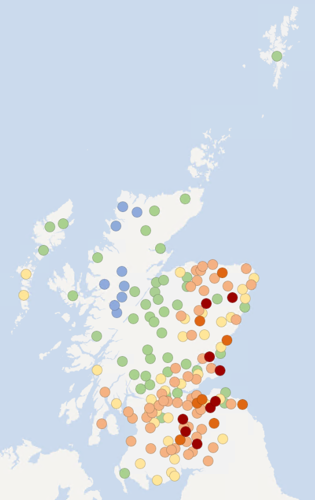
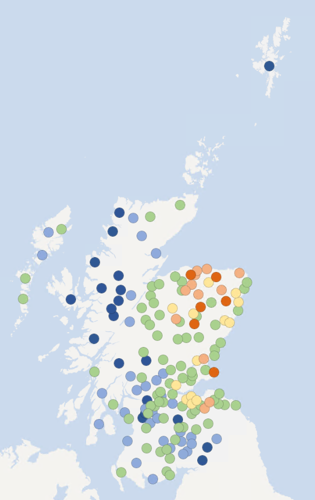
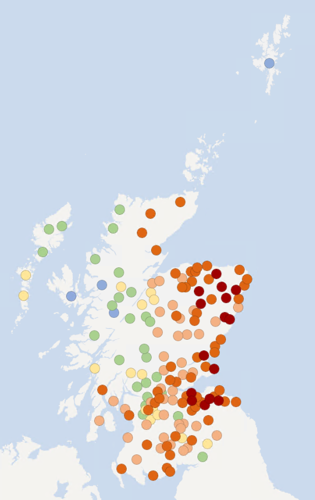
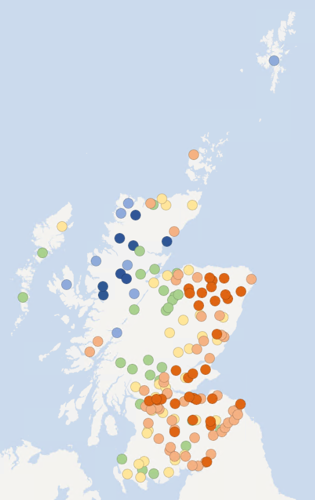
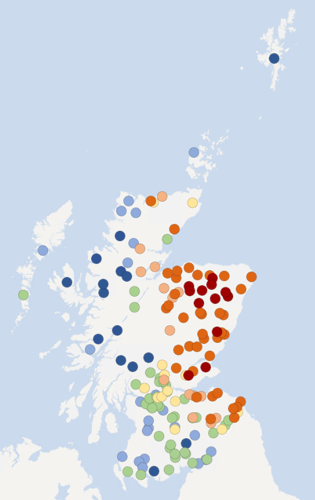
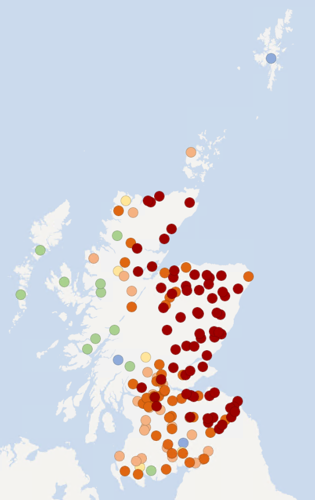
What do the map colours mean?
| Rainfall | Extremely dry | Very dry | Dry | Quite dry | Normal conditions | Wet | Very wet |
|---|---|---|---|---|---|---|---|
| River flow | Extremely low | Very low | Low | Quite low | Normal conditions | High | Very high |
| Red | Orange | Light orange | Yellow | Green | Light blue | Dark blue |
Soil moisture deficit
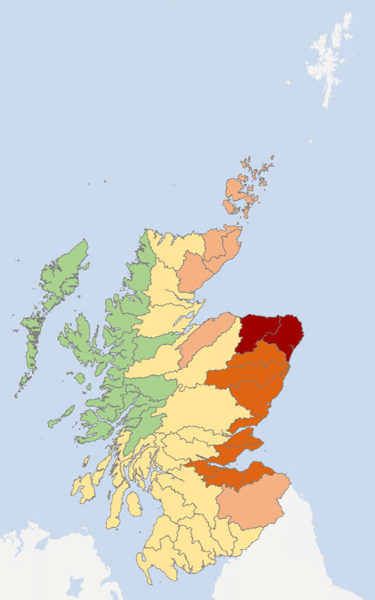
This map shows this week’s soil moisture deficit. This is obtained from the Met Office Rainfall and Evaporation Calculation System (MORECS). This map shows this week’s soil moisture deficit. This is obtained from the Met Office Rainfall and Evaporation Calculation System (MORECS). The Ythan and Deveron catchments show extremely dry ground conditions. Ground conditions across the rest of the east are mostly dry to very dry. In the south-west there is generally quite dry ground conditions while in the north-west there is no deficit.
What do the map colours mean?
| Extremely dry | Very dry | Dry | Quite dry | No deficit |
|---|---|---|---|---|
| Red | Orange | Light orange | Yellow | Green |
Natural water storage – groundwater and loch levels
In each river catchment there is some degree of natural water storage, which can maintain river flows even when it is not raining. This natural water storage is mainly held in lochs and groundwater. When storage has been depleted it will take a lot of rainfall for levels to recover.
The maps below show recent groundwater and loch level compared to the long-term record at each individual station. Level is reported as high or low compared to the typical (‘normal’) level range for the time of year.
Level ranges are specific to each station and based on the long-term (minimum 10 years) record of mean monthly level values recorded at individual stations.
Despite the recent rainfall, due to the lack of recharge over the autumn and winter, groundwater levels across most of the country remain low to very low for the time of year.
Locations in Fife have recorded their lowest levels for July on record. In its 28-year record the Newton of Falkland borehole has only recorded levels this low once before, in July to October 2006, and Scotlandwell recorded its lowest July level in its 27-year record. Boreholes in the Ythan catchment in Aberdeenshire are also close to or at the lowest levels previously seen in July.
Without significant rainfall, groundwater levels are expected to continue to fall over the summer.
July average loch levels are low in the northeast of Scotland with levels elsewhere between normal and very high.

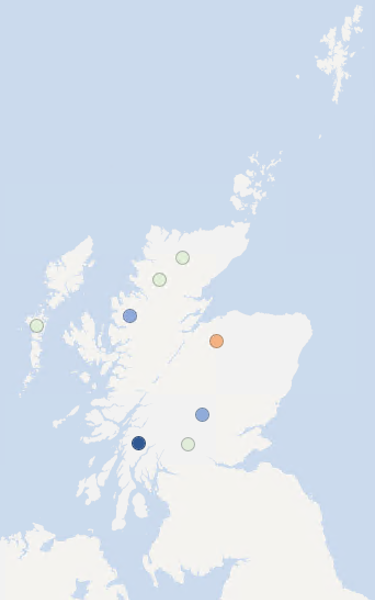
What do the map colours mean?
| Very high | High | Normal range | Low | Very low |
|---|---|---|---|---|
| Dark blue | Light blue | Light green | Light orange | Dark orange |
Flow, rainfall and groundwater data are accessed via SEPA's time series data service (API). SEPA's live data are subject to ongoing quality control and periodic review.
Scottish Water are responsible for public water supply and distribution in Scotland. Scottish Water reports on the raw water stored in these supplies.
Report copyright
- Current water scarcity levels - © SEPA. Some features of this information are based on digital spatial data licensed from the Centre for Ecology and Hydrology © NERC (CEH). Contains OS data © Crown copyright (and database right).
- Areas of significant water scarcity - OS Data - © Crown Copyright - SEPA licence number 100016991 (2022)
- Rainfall, river flow, groundwater and loch levels - Base map © OpenStreetMap contributors.
- Soil moisture deficit - Data based on MORECS (Met Office © Crown Copyright). Some features of this information are based on digital spatial data licensed from the Centre for Ecology and Hydrology © NERC (CEH). Contains OS data © Crown copyright (and database right). Base map © OpenStreetMap contributors.
- Weather forecast - Crown copyright [2022], Met Office
